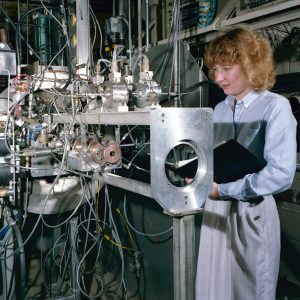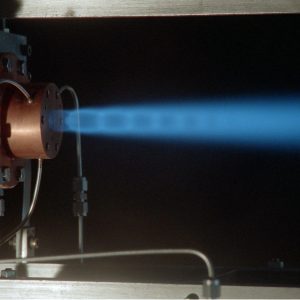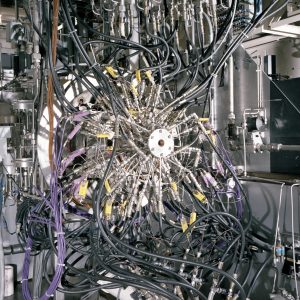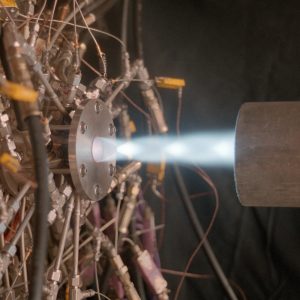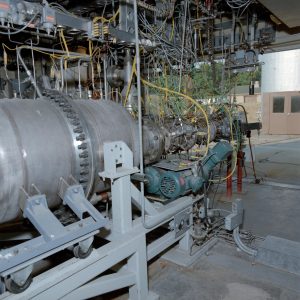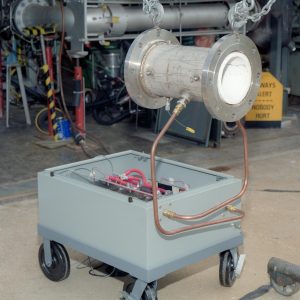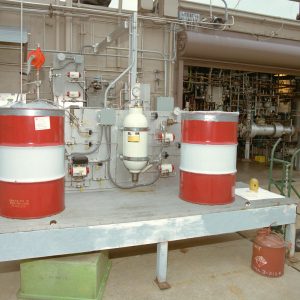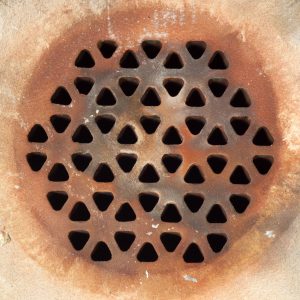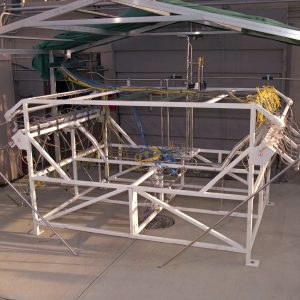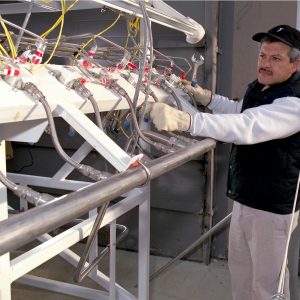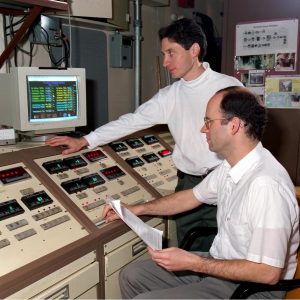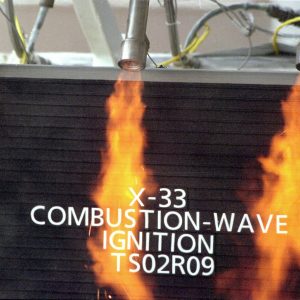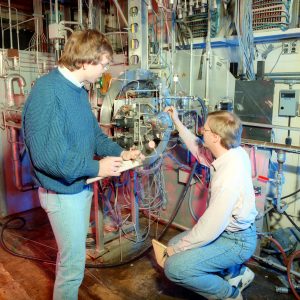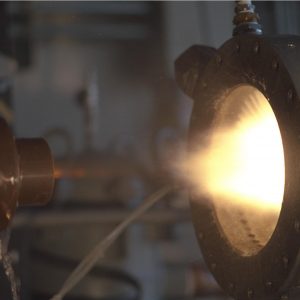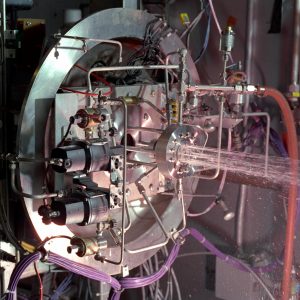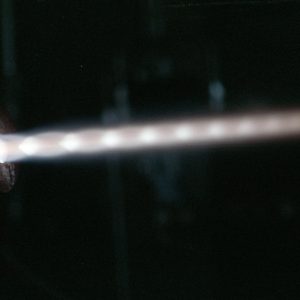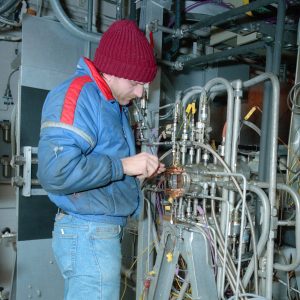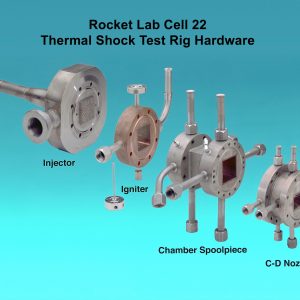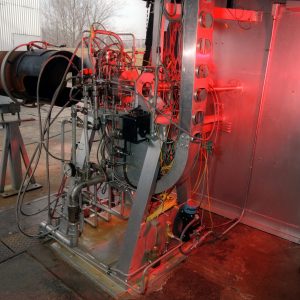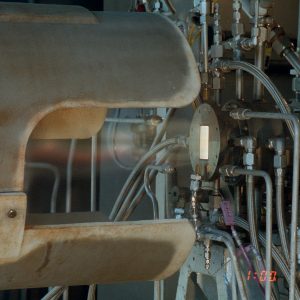Return to Rockets
Overview
In the mid-1980s and 1990s the Rocket Laboratory was upgraded to support technologies for the nation’s next space missions. The space shuttle had begun flying missions and plans for the development of the space station was underway. In addition, with the end of the Cold War, there was interest in returning to the Moon and travelling to Mars.
Cells 11 and 21 underwent major rehabilitation during this period to provide advanced laser diagnostics and vacuum testing capabilities. The Rocket Lab was utilized for combustion, altitude thrusters, rocket ignition, novel fuels, high-temperature materials and coating development, and life testing of resistojets arcjets and other small thrusters.
The name of the facility changed several times in later years, but is referred to as the Rocket Lab throughout this website. It was named the Combustion Research Laboratory (1981-1989). the Rocket Laboratories (1989-1996); Research Combustion Laboratory (1996-2020).
Propellants from Martian Atmosphere
The Center has been conducting materials research since the 1940s. Strong, lightweight, and high-temperature materials are critical elements for a variety of aerospace applications, particularly propulsion systems. As national interest in supersonic and hypersonic flight increased in the 1980s with efforts such as the X-30 National Aerospace Plane (NASP), it was necessary to identify materials, such as silicon-carbide-based ceramic matrix composites, that could withstand the extreme temperatures of high-speed flight.
In the 1980s, a hydrogen and oxygen test stand was installed in Cell 22 to test materials in conditions that simulated the high temperature, high pressure, velocity, and thermal shock experienced by hypersonic engines.
In the early 1990’s, the high-heat facility was used to study the reaction of protected leading-edge coatings in this environment and to determine the benefits of pre-oxidizing the coating. Four samples were tested over a range of thermal shock and cyclical conditions. The coatings performed well in a hydrogen-rich environment but degraded progressively as the oxygen levels increased. The Cell 22 facility was also used to determine if transpiration cooling of a porous ceramic rope seal was sufficient enough to prevent heat damage to the engine. The heat transfer data, however, did not align with their predictions.
In the mid-2000s, Cell 22 was used to support materials development for the Integrated High Payoff Rocket Propulsion Technology (IHPRPT) program, a government and industry effort to improve U.S. rocket propulsion systems. The researchers created computer models to predict the stability and recession rates of silicon-carbide-based ceramic matrix composites. These composites, which provided substantial weight savings over more traditional metallic parts, were under consideration for transpiration-cooled injector faceplates and thrust chamber liners. These materials were subjected to the high temperatures of hydrogen and oxygen combustion in the Cell 22 high-heat facility to verify the computer models.
Documents
- Carbon monoxide and oxygen ignition experiments (1990)
- Carbon monoxide and oxygen combustion experiments (1991)
- Heat transfer characteristics of carbon monoxide and oxygen engine (1993)
Aircraft Emissions Testing
The lowering of emissions has been a critical element of the Center’s continual effort to improve aircraft engines. The flametube facility in Cell 23 was used for a number of emission reduction studies in the early 1990s. The flametube setup was capable of testing fuel injectors in a high-temperature simulated combustion chamber atmosphere. It could separate the different stages of the combustion process to analyze nozzle configurations.
Cell 23 was used to test various types of catalysts with different materials to support NASA’s High-Speed Civil Transport program. In an effort to reduce nitrogen oxides at high altitudes, engineers considered the use of two-stage combustion to minimize the reaction during the period of peak nitric oxide production. Cell 23 was used to test different catalysts that sparked the first stage of the combustion, which vaporizes the fuel into the incoming air flow. They were operated in steady state over a range of conditions in the cell’s flametube facility.
In the 1990s, there was a renewed interest in hydrogen-fueled aircraft, with increased emphasis on reducing emissions. Hydrogen engines do not emit carbon monoxide, carbon dioxide, sulfur oxide, hydrocarbons, and smoke; but they do emit low levels of nitrogen oxide. NASA initiated the Zero CO2 Engine Technology project to study utilizing lean direct injection (LDI), lean premixed, and hybrid fuel injectors for hydrogen engines. The injectors were tested in the Cell 23 flametube facility, which was modified to use gaseous hydrogen as a propellant. It was found that use of the LDI method with hydrogen produced significantly higher flashback rates than with jet fuel. The flashback was reduced by minimizing the air/fuel mixing time and increasing the velocity. The test program showed that some of the injector configurations produced nitrogen oxide emissions on par with modern jet fuel injectors.
As part of the General Aviation Program, Cell 23 was used to test two Teledyne Ryan Aeronautics combustors over 10 days in June 1996. The researchers successfully operated the gasoline combustors in over 240 different variations to study their starting, combustion efficiency, emissions, and limits. The results were excellent.
Documents
- Fuel-rich, catalytic reaction experimental results (1991)
- Hydrogen/Air Fuel Nozzle Emissions Experiments (2000)
- Low emission hydrogen combustors using lean direct injection (2004)
X-33 Combustion Wave Ignition
The Center was involved in several key aspects of the X-33 VentureStar experimental spacecraft development, including testing the novel combustion wave ignition (CWI) system at the Rocket Lab. The X-33, which launched vertically but landed horizontally, was seen as a possible replacement for the space shuttle and a rescue vehicle for the space station. Rocketdyne designed the CWI system for its XRS-2200 Linear Engine so that the propellants ignited in several locations. This reduced weight and energy consumption but required precision timing and premixing and gasification of the fuel.
The CWI test rig was installed behind Cell 21 to investigate the performance and operating envelopes of the flight-weight CWI configuration. The test program began in early 1997 with the firing of a single gaseous hydrogen and gaseous oxygen element. These were followed in April 1998 by 103 hot firing tests of a full-scale model with liquid propellants in a simulated flight atmosphere. The flight-weight CWI system was tested under varying temperatures, pressures, and propellant mixtures.
The Cell 21 CWI test program verified the soundness of the design and determined the key operational characteristics. The X-33 program was cancelled in 2001 due to funding issues before any flight tests had taken place.
Documents
- X-33 Advanced Technology Demonstrator Fact Sheet
- Combustion Wave Ignition for Rocket Engines (1992)
- CWI Test Operational Readiness Review (1998)
- X-33 Combustion-Wave Ignition System Tested (1998)
Metallized Propellants
Metallized propellants are fluids into which powdered metal is also added. The Center first investigated metallized propellants in the early 1960s as an option to flow fuels to turbopumps operating in the microgravity environment of space. Although not utilized as such, interest in metallized propellants resurfaced in the 1980s. It was theorized that metallized gelled propellants would be denser than traditional fuels, and thus possess more energy to deliver payloads. The density would also increase stability in storage and limit the damage in the case of spills but remain throttleable.
In 1987, researchers began both experimental and mission analysis for metallized propellants, primarily the RP-1-liquid oxygen combination with aluminum particles added. Aluminum possessed the highest potential specific impulse but issues such as complete combustion and fluid flow had to be resolved.
A 100-pound-thrust engine in Cell 21 at the Rocket Lab was used in the early 1990s for extensive testing of the ignition, combustion, and heat transfer of variations of the RP-1-liquid oxygen-aluminum propellant. This included the first rocket firing ever using up to 55% aluminum gelled in a JP-10 fuel.
In the mid-2000s, Cell 21 was used to test metallized gelled propellants in a pulse detonation engine. Pulse detonation systems, which do not require turbopumps to pump the propellants, are potentially more efficient than traditional liquid fueled engines. The Cell 21 investigations used a Constant Volume Combustion Cycle Engine testbed that allowed the use of various injectors and igniters. The researchers used single-pulse firings to determine the performance of the metallized gelled fuel and improve combustion.
Documents
- Ignition and Combustion of Metallized Propellants (1989)
- Subscale Powdered Aluminum and Oxygen Combustion (1993)
- Oxygen/RP-1/Aluminum Rocket Combustion Experiments (1995)
- Oxygen/RP-1/Aluminum Rocket Heat Transfer and Combustion (1996)
- Metallized Gelled Propellants in a Pulse Detonation Engine (2006)
Materials for Hypersonic Flight
NASA Lewis has been conducting materials research since the 1940s. Strong, lightweight, and high-temperature materials are critical elements for a variety of aerospace applications, particularly propulsion systems. As national interest in supersonic and hypersonic flight increased in the 1980s with efforts such as the X-30 National Aerospace Plane (NASP), it was necessary to identify materials, such as silicon-carbide-based ceramic matrix composites, that could withstand the extreme temperatures of high-speed flight.
In the 1980s, a hydrogen and oxygen test stand was installed in Cell 22 to test materials in conditions that simulated high temperature, high pressure, velocity, and thermal shock experienced by hypersonic engines. Cell 22
In the early 1990s, the high heat facility was used to study the reaction of protected leading-edge coatings in this environment and to determine the benefits of pre-oxidizing the coating. Four samples were tested over a range of thermal shock and cyclical conditions. The coatings performed well in a hydrogen-rich environment but degraded progressively as the oxygen levels increased. The Cell 22 facility was also used to determine if transpiration cooling of a porous ceramic rope seal was sufficient enough to prevent heat damage to engine. The heat transfer data, however, did not align with their predictions.
In mid-2000s, Cell 22 was used to support materials development for the Integrated High Payoff Rocket Propulsion Technology (IHPRPT) program, a government and industry effort to improve U.S. rocket propulsion systems. NASA Glenn researchers created computer models to predict the stability and recession rates of silicon-carbide-based ceramic matrix composites. These composites, which provided substantial weight savings over more traditional metallic parts, were under consideration for transpiration-cooled injector faceplates and thrust chamber liners. These materials were subjected to the high temperatures of hydrogen and oxygen combustion in the Cell 22 high heat facility to verify the computer models.
Documents
- A Versatile Rocket Engine Hot Gas Facility (1994)
- Hypersonic engine experiments in a high heat flux environment (1993)
- Integrated High Payoff Rocket Propulsion SiC Recession Model (2009)


